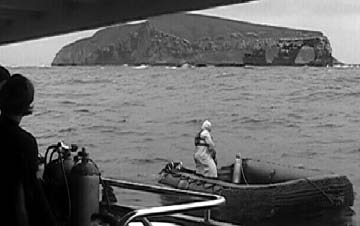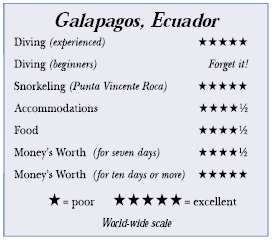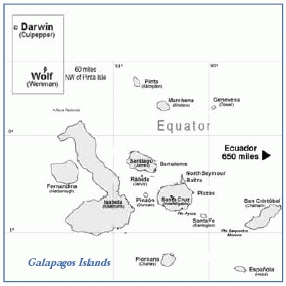Sky Dancer, Galapagos, EcuadorContents of this Issue: Sky Dancer, Galapagos, Ecuador Five Well-Rated Galapagos Live-aboards Holbox Whale Sharks, Bonaire Wild Side PADI Anti-Defamation Lawsuit Tossed Out The Apeks Tungsten Regulator: bling bling Those Divebag Security Screeners Ship Ahead Rather Than Carry Your Gear? DAN Insurance: Rejected by Some Editorial Office: Ben Davison Publisher and Editor Undercurrent 3020 Bridgeway, Suite 102 Sausalito, CA 94965 superlative sensory overload from the February, 2006 issue of Undercurrent
Dear Reader: “All I could see was haze...then there was this enormous mouth.” That’s as good a description of a diver’s first whale shark sighting as I’ve heard. We were in the blue off Darwin’s Arch, the oft-photographed geological formation at Darwin Island, among Ecuador’s northern Galapagos’ Islands. It was the first of three whale shark sightings...but were we seeing different whale sharks, or the same 10-meter shark three times? But why care? By the third day of my week-long journey on board the Peter Hughes Sky Dancer, care was a bygone concern. Having expended considerable time and money for this trip, my only complaint was the endless parade of hot snacks the captain pressed on us every time we climbed aboard following a dive.
Operating either out of the Galapagos’ ports of Baltra or Puerto Ayora, the 100 ft. Sky Dancer is big and fast enough to make the 8-10 hour crossing to Wolf and Darwin islands in time for at least a full day of diving at each, a critical element in selecting a seven-day trip. Wolf and Darwin are where the big pelagics congregate. And you want a big boat, because in late September this 15-hour trip back got rough, as several seasick passengers discovered. At these rugged, uninhabited islands, the visibility (30-60 ft., depending on cloud cover) doesn’t compare with that of the South Pacific. Nonetheless, by the time I counted 52 hammerheads swimming past, I had forgotten about gin-clear waters. While the currents were never ripping, they were significant enough to make diving awkward for two relative novices aboard. Still, no one ever got separated from the group, since divers took care to keep their divemaster in sight while simultaneously leaving the wall for panga pickups. Divers themselves were charged with monitoring their own air supplies. There were no hard and fast dive times, but for those who gulped air faster than others, one divemaster would leave the wall with them. The others could remain behind with the second divemaster. Generally, no one objected to leaving for the blue –- that’s where the dolphins and whale sharks were . . . not to mention the pleasure of swimming into a big school of hammerheads. The underwater geology is largely rocky and volcanic, with smatterings of coral, reminiscent of Hawaii. Typically, we dropped to 60-70 ft., found a nice soft rock, settled in, and watched the show. My Kevlar gloves protected me from the barnacles that festooned the numerous boulders while also keeping my fingers warm. I literally brushed wrasses and snappers away from my mask to view the parade, which included meandering turtles, Spanish mackerel, schools of bonito that looked like the chrome stripped from a ’58 Oldsmobile, giant trevally, and huge schools of feeding fish. The rocks at my feet boasted blue nudibranchs and dozens of speckled morays. On one dive, 10 eagle rays hovered nearly vertically, like box kites on strings, just off the sloping wall. On another dive, four drifted in close enough to touch. The second dive at Wolf demanded an extended safety stop in the blue because no one wanted to get out of the water; you see, a half dozen bottlenose dolphins insisted on playing tag with us. Galapagos sharks, big, husky, and handsome (no skinny whitetips these), would swim among us, often at arm’s length, once producing a Gary Larson cartoon moment. As our group of eight hugged boulders and watched the fish parade, about 20 big Galapagos sharks made their way through us. While one diver pointed out a shark cruising past his friend, another shark skimmed unseen right over his head. A third diver was literally pirouetting to view one shark passing in front of him and another behind. Two divers seeking a better viewing position were so entranced they swam into each other. Think human viewing frenzy, with the sharks the ones who were calm and relaxed, probably tut-tutting as they swam past.
I’ve dived all over the world, but mostly in warm water. On our checkout dive with a heavier suit than I was accustomed to, I bobbed like a cork. Adding weight, I went down easier the second time. Much better, except for a growing unease. No air. I was sucking an empty tank. Despite my hundreds of dives, I had forgotten the basic rule: Always check your tank before entering the water. Embarrassed rather than concerned, I surfaced and had to be hauled back to the Dancer by panga to get a filled tank. Yes, a member of the crew should have checked the tank fill, but it was foremost my responsibility. I also snorkeled. Not only did I stay warmer, but I saw a marine iguana swimming toward me, dozens of turtles, penguins (you cannot believe how fast these pudgy little guided missiles travel), and four young sea lions. One would hide underwater among the rocks until I spotted it, then dash away to hide elsewhere until found it. I finally ran out of breath and had to rejoin our panga. The Sky Dancer has plenty of public space, including a huge upper deck with hammocks and deck lounges, but the sun’s frequent absence left it almost deserted –- except for pelicans who, looking like out-of-work comedians, would perch everywhere, utterly unimpressed by the human inhabitants. A large lounge inside is equipped with a small library and TV/DVD setup, with movies. The dining area consists of four booths set with white linen table cloths, silverware, and glasses, that seated all 16 divers (14 hailed from the U.S., one from Israel and one from Britain)comfortably.
At dinner, the waiter took orders for soup, followed by your choice from two main courses with side dishes and salad. And, of course, complimentary wine. Vegan requests were accommodated. Desserts were less inspired, but I’m getting picky. The bar provided complimentary beer, liquor, and soft drinks. Containers of chips and hard candies were set out in the lounge. Eight cabins offer about the same space, but the four upper deck cabins have large beds and windows. The four lowers feature twin bunks and portholes. Upper cabins are quieter, as the forward below-deck cabins can take a pounding. Drawer space is adequate, the small closet for hanging clothes less so. A/C is individually controlled per cabin. In private bathrooms, standard sized showers delivered plenty of hot water. There are also two hot water showers on the dive deck, great after cold dives, and yes, the famous Hughes’ bathrobes. The dive deck is large enough to allow you to gear up without pinballing off your neighbors. The same tank and space remain yours for the trip. Beneath the steel seat is a plastic crate for small gear. There’s a big camera table with open storage (for Pelican cases, etc.). Fins are brought to each of the two pangas (rigid inflatables) after the fully-geared divers have boarded. Before boarding a panga, your well-filled –- usually -- 3000 psi aluminum tank is checked by crew members to make sure the air is on. In high seas, boarding can be tricky. But the crew helped, and no one suffered a fall. Getting into the panga after a dive was tough for some divers. There are no ladders. After passing up your weight belt and tank rig, you kick hard, pull on the side ropes, and flop forward. It’s unglamorous to be hauled in like a gaffed fish and nearly everyone needed a hand now and then. The key to comfortable diving with pangas isn’t their length. It’s width. The Dancer pangas are big enough to dump eight divers in the water with simultaneous backward rolls, though you may catch a fin in the face until everyone spreads out. And safety is paramount. No panga returns to the Dancer until all divers are up. Divers are issued yellow, waterproof emergency broadcast units. Smaller than a home telephone handset, these slip into pockets or are clipped to your BC. In an emergency, you snap the unit on and flip up the antenna. The signal can be tracked from the Dancer, and even by satellite. Use them only in true emergencies (e.g., you’re headed for Mexico) lest the Ecuadorian Coast Guard picks up the signal and comes hunting for you. The eight-man Ecuadorian crew is confident they run the best dive boat in the Galapagos, and their pride shows. You can tell a well-run operation if crew members work outside their specialty. When the cook helps remove dive gear after a dive, and the captain serves the snacks, you know they’re pulling together. The captain, incidentally, was always available to show the bridge and entertain requests for possible changes to the itinerary. Our divers once voted to sacrifice a visit to a central island dive site and a land excursion in favor of more dives at Wolf and Darwin. For the big stuff, high season is September-October. In low season, the air is clearer and toasty, the visibility better, the water warmer. You’ll still see a lot, just not as much. Either time, where else are you going to dive with banner butterfly fish and penguins on the same trip? Not to mention the big guys. --S.W.
|

I want to get all the stories! Tell me how I can become an Undercurrent Online Member and get online access to all the articles of Undercurrent as well as thousands of first hand reports on dive operations world-wide
| Home | Online Members Area | My Account |
Login
|
Join
|
| Travel Index |
Dive Resort & Liveaboard Reviews
|
Featured Reports
|
Recent
Issues
|
Back Issues
|
|
Dive Gear
Index
|
Health/Safety Index
|
Environment & Misc.
Index
|
Seasonal Planner
|
Blogs
|
Free Articles
|
Book Picks
|
News
|
|
Special Offers
|
RSS
|
FAQ
|
About Us
|
Contact Us
|
Links
|
3020 Bridgeway, Ste 102, Sausalito, Ca 94965
All rights reserved.


 The main central islands have their own charms. At North Seymour I watched
whitetips, schooling snappers, a couple of sea lions, and a weird ray not even
the divemasters could identify. At Punta Vincente Roca off Isabella Island, I saw a bait-ball of sardine-size fish, a big
school of porcupine fish, more sea lions,
and mola-molas (ocean sunfish), even four
of them in tandem. On the downside, the
water here was not the 71ºF of Darwin and
Wolf, but a chilling 61ºF. My 5mm Farmer
John (bought used for $40 at Play It Again
Sports) kept me warm in the north, but in
the south I was cold.
The main central islands have their own charms. At North Seymour I watched
whitetips, schooling snappers, a couple of sea lions, and a weird ray not even
the divemasters could identify. At Punta Vincente Roca off Isabella Island, I saw a bait-ball of sardine-size fish, a big
school of porcupine fish, more sea lions,
and mola-molas (ocean sunfish), even four
of them in tandem. On the downside, the
water here was not the 71ºF of Darwin and
Wolf, but a chilling 61ºF. My 5mm Farmer
John (bought used for $40 at Play It Again
Sports) kept me warm in the north, but in
the south I was cold. The breakfast buffet supplied
plenty of fruit, several fruit juices
(the pitchers need to be labeled --
guests who could rattle off the scientific
names of fish drew a complete
blank when it came to identifying the
juices), breads, bacon, and eggs to
order. When I asked for an omelet
(cheese, mushroom, and bacon, please),
it was cheerfully forthcoming. French
toast is another on-request option.
The buffet lunch consisted of salads
with pasta, tuna, etc., and several
hot dishes.
The breakfast buffet supplied
plenty of fruit, several fruit juices
(the pitchers need to be labeled --
guests who could rattle off the scientific
names of fish drew a complete
blank when it came to identifying the
juices), breads, bacon, and eggs to
order. When I asked for an omelet
(cheese, mushroom, and bacon, please),
it was cheerfully forthcoming. French
toast is another on-request option.
The buffet lunch consisted of salads
with pasta, tuna, etc., and several
hot dishes.  Diver’s Compass: Up to four dives/day (occasional night dives,
but nothing special), some land excursions. Air to Galapagos
was $524 RT from Quito...some 7mm and other suits available for
rental, but reserve in advance; a 5/3 mm hooded vest is wise...
Nitrox $150/week, $200/10 days. Nitrox certification available
on board...There is a hyperbaric chamber in Puerto Ayora...Late
September air mostly in mid-70s to mid-60s, cooler at night...Most
flights to Ecuador are on American via Miami. I prefer Continental
from Houston...If you want to see Ecuador, go through Quito, not
Guyaquil...Quito’s Hotel Mercure has terrific refurbished rooms with king beds,
in-room safe, minibar, direct-dial, 70 channels of TV, friendly English-speaking
staff, great snack bar outside on street...I negotiated directly with hotel (
Diver’s Compass: Up to four dives/day (occasional night dives,
but nothing special), some land excursions. Air to Galapagos
was $524 RT from Quito...some 7mm and other suits available for
rental, but reserve in advance; a 5/3 mm hooded vest is wise...
Nitrox $150/week, $200/10 days. Nitrox certification available
on board...There is a hyperbaric chamber in Puerto Ayora...Late
September air mostly in mid-70s to mid-60s, cooler at night...Most
flights to Ecuador are on American via Miami. I prefer Continental
from Houston...If you want to see Ecuador, go through Quito, not
Guyaquil...Quito’s Hotel Mercure has terrific refurbished rooms with king beds,
in-room safe, minibar, direct-dial, 70 channels of TV, friendly English-speaking
staff, great snack bar outside on street...I negotiated directly with hotel (